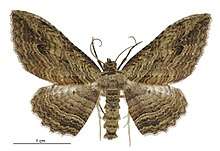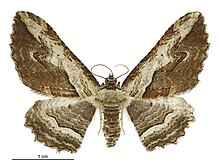Austrocidaria anguligera
Austrocidaria anguligera is a species of moth in the family Geometridae. It is endemic to New Zealand. It is regarded as being uncommon but is frequently confused with Austrocidaria bipartita.
| Austrocidaria anguligera | |
|---|---|
 | |
| Male | |
 | |
| Female | |
| Scientific classification | |
| Kingdom: | Animalia |
| Phylum: | Arthropoda |
| Class: | Insecta |
| Order: | Lepidoptera |
| Family: | Geometridae |
| Genus: | Austrocidaria |
| Species: | A. anguligera |
| Binomial name | |
| Austrocidaria anguligera (Butler, 1879) | |
| Synonyms | |
| |
Taxonomy
This species was first described by Arthur Gardiner Butler in 1879 using specimens collected by Frederick Hutton in Dunedin and given the name Phibalapteryx anguligera.[1][2] George Vernon Hudson discussed and illustrated this species in his 1898 book as a synonym of Hydriomena gobiata.[3] In his 1928 publication The Butterflies and Moths of New Zealand Hudson again illustrated and discussed the species, but under the name Eucymatoge anguligera following Edward Meyrick's placement of the species within that genus.[4][5] In 1988 John S. Dugdale assigned the species to a new genus Austrocidaria.[1] The holotype specimen is held at the Natural History Museum, London.[1]
Description
Butler described the adult moths of the species as follows:
♀ More sandy in coloration than P. gobiata, with a distinct oblique olivaceous brown central belt, limited by the discal blackish line, which is widely zigzag, but diverging from this line above the lower radial, whence it runs transversely but irregularly to the costal margin; a large dusky discocellular spot; veins on the disc white dotted with black as usual; secondaries with the margin rather more strongly dentated than in P. gohiata, the inner blackish line represented by a grey band; outer border limited by a dusky line; a slender black marginal line; primaries below with a lakey tint; the discocellular dot black ; a transverse irregular discal line answering to that of the upper surface ; secondaries pale sandy-whitish, the basal half crossed by five dusky lines ; disc crossed by a darker sandy nebula. Expanse of wings 1 inch 4 lines.[2]
A. anguligera is sometimes confused with A. bipartita,[6] with the latter being the more common species.[7]
Distribution
This species is endemic to New Zealand.[8][9] It has been found in Canterbury,[10] Otago,[2] Invercargill,[5] and Otira in the South Island, as well as in Auckland and Wellington in the North Island.[4]
Biology and behaviour
The adults of this species are on the wing from September to March.[4] They can be found resting on tree trunks or fence posts during the day.[4]
Habitat and host species
This species prefers scrubby forest habitat.[4] It occurs in a variety of ecosystems from montane to coastal.[7] The larvae of this moth feeds on Coprosma species.[11][12] Meyrick noted that the adults of this species could be found on the flowers of Senecio species.[5] Hudson stated that the adult moths fed on the flowers of Hebe salicifolia.[4]
References
- Dugdale, J. S. (1988). "Lepidoptera - annotated catalogue, and keys to family-group taxa" (PDF). Fauna of New Zealand. 14: 175. Retrieved 7 July 2018.
- Butler, Arthur Gardiner (1879). "On a small collection of Heterocerous Lepidoptera, from New Zealand". Cistula Entomologica. 2: 487–511 – via Biodiversity Heritage Library.
- Hudson, G. V. (1898). New Zealand moths and butterflies (Macro-lepidoptera). London. p. 47. doi:10.5962/bhl.title.7912. OCLC 727236768. Retrieved 7 July 2018.
- Hudson, G. V. (1928). The Butterflies and Moths of New Zealand. Wellington: Ferguson & Osborn Ltd. p. 98. OCLC 25449322.
- Meyrick, Edward (1909). "Notes and Descriptions of New Zealand Lepidoptera". Transactions and Proceedings of the New Zealand Institute. 41: 5–16 – via Biodiversity Heritage Library.
- "Austrocidaria bipartita: Similar Species". iNaturalist.org. Retrieved 3 June 2020.
- "T.E.R:R.A.I.N - Taranaki Educational Resource: Research, Analysis and Information Network - Austrocidaria anguligera". www.terrain.net.nz. Retrieved 2018-07-07.
- Gordon, Dennis P., ed. (2010). New Zealand Inventory of Biodiversity. Volume two. Kingdom Animalia: Chaetognatha, Ecdysozoa, Ichnofossils. 2. Christchurch, N.Z.: Canterbury University Press. p. 459. ISBN 9781877257933. OCLC 973607714.
- "Austrocidaria anguligera (Butler, 1879)". www.nzor.org.nz. Landcare Research New Zealand Ltd. Retrieved 2018-07-07.
- Scott Hooson (30 January 2015). Christchurch District Plan Site of Ecological Significance: Lathams (PDF) (Report). Christchurch City Council. pp. 1–17. Retrieved 7 July 2018.
- Patrick, Hamish J.H.; Bowie, Mike H.; Fox, Barry W.; Patrick3, Brian H. (2011). "The moths of Quail Island (Ōtamahua): a faunal comparison of an island under restoration with other sites on Banks Peninsula" (PDF). New Zealand National Sciences. 36: 57–72. Archived from the original (PDF) on 3 March 2016. Retrieved 7 July 2018.
- White, E. G. (1991). "The changing abundance of Moths in a Tussock grassland, 1962-1989, and 50- TO 70-year trends" (PDF). New Zealand Journal of Ecology. 15: 5–22.
External links
| Wikimedia Commons has media related to Austrocidaria anguligera. |